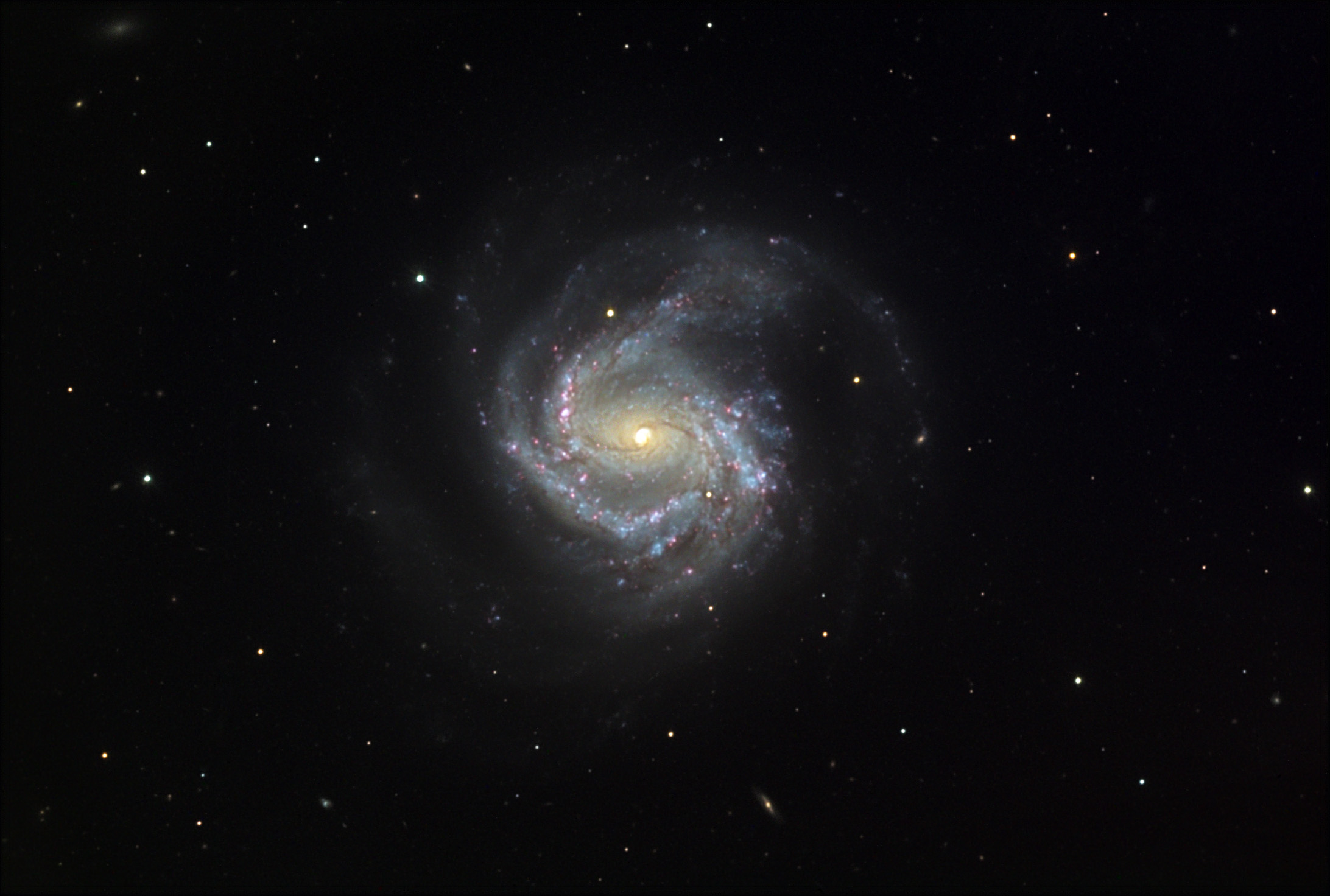
When it comes to exploring the wonders of the Universe, Messier 61 (M61) holds a special place in the hearts of astronomers and space enthusiasts alike. This intriguing spiral galaxy, located approximately 52 million light-years away in the constellation Virgo, has fascinated researchers for decades.
Known as the “Spindle Galaxy” due to its elongated shape, M61 offers a wealth of captivating features and intriguing facts that pique the curiosity of those who yearn to learn more about the vastness of our cosmic neighborhood. From its active galactic nucleus to its intricate spiral arms, this celestial object offers a plethora of knowledge waiting to be discovered.
In this article, we will delve into 11 intriguing facts about Messier 61, shedding light on its unique characteristics and the scientific discoveries it has revealed. Brace yourself for a cosmic journey like no other as we uncover the mysteries hidden within this captivating spiral galaxy.
Key Takeaways:
- Messier 61, also known as M61, is a fascinating galaxy with tight spiral arms, intense star formation, and a supermassive black hole. It’s part of the Virgo Cluster and showcases beautiful tidal tails.
- Discovered in 1779, M61 is relatively close to the Milky Way and has been extensively studied by astronomers worldwide. Classified as a Seyfert galaxy, it continues to captivate scientists and stargazers with its unique characteristics.
Messier 61 is also known as NGC 4303.
Messier 61, commonly referred to as M61, is an intermediate barred spiral galaxy located in the Virgo constellation. It is also identified by its catalog number NGC 4303.
M61 was discovered by Barnaba Oriani in 1779.
Messier 61 was first observed by Italian astronomer Barnaba Oriani on May 5, Oriani cataloged it as a nebula, but it was later recognized as a galaxy.
Messier 61 has a diameter of about 100,000 light-years.
This fascinating galaxy extends an impressive distance, with an estimated diameter spanning around 100,000 light-years. It contains billions of stars, gas, and dust.
The spiral arms of M61 tightly wind around its central bar.
Messier 61 stands out for its prominent spiral arms that tightly coil around a central bar structure. This bar is composed of stars, and it plays a crucial role in the dynamics of the galaxy.
M61 exhibits intense star formation activity.
This galaxy is known for its vigorous star-forming activity, which can be observed through the presence of numerous young, bright blue stars. These stars are typically found in the spiral arms.
Messier 61 is part of the Virgo Cluster of galaxies.
M61 resides within the Virgo Cluster, a rich grouping of galaxies located approximately 55 million light-years away from Earth. The gravitational interaction between galaxies in the cluster has influenced the evolution of M61.
M61 has a supermassive black hole at its center.
Like many other galaxies, M61 harbors a supermassive black hole at its core. This black hole has a mass estimated to be around 5 million times that of our Sun, exerting a powerful gravitational pull.
It is classified as a Seyfert galaxy.
Messier 61 is classified as a Seyfert galaxy, characterized by its bright, active nucleus. Seyfert galaxies are known to exhibit strong emission lines in their spectra, indicating the presence of superheated gas.
M61 is located relatively close to the Milky Way.
Compared to other galaxies, M61 is considered to be relatively close to our own Milky Way galaxy. It is situated at a distance of approximately 55 million light-years, making it within reach of scientific study.
It has been the subject of extensive research.
Due to its proximity and unique characteristics, Messier 61 has attracted the attention of astronomers worldwide. Numerous studies have been conducted to better understand its structure, dynamics, and star formation processes.
Messier 61 showcases beautiful tidal tails.
One remarkable feature of M61 is the presence of tidal tails. These elongated structures, stretching out from the galaxy, are a result of gravitational interactions with neighboring galaxies within the Virgo Cluster.
These 11 intriguing facts about Messier 61 (M61) highlight its significance in the realm of astronomy. From its stunning spiral arms and active star formation to its location within the Virgo Cluster, M61 continues to captivate scientists and stargazers alike. With ongoing research, we hope to uncover even more about the mysteries hidden within this remarkable galaxy.
Conclusion
In conclusion, Messier 61 (M61) is a fascinating astronomical object that holds numerous intriguing facts. From its classification as a barred spiral galaxy to its active galactic nucleus and peculiar shape, M61 has captured the attention of astronomers and astrophysics enthusiasts alike. Its supermassive black hole and abundance of star-forming regions provide valuable insights into the dynamics and evolution of galaxies.Furthermore, M61’s association with the Messier catalog adds to its significance in the field of astronomy. The various studies and observations carried out on this galaxy have shed light on its unique characteristics and contributed to our understanding of the universe.Whether you are an avid stargazer or simply curious about the wonders of the cosmos, exploring Messier 61 is sure to ignite a sense of wonder and awe. Its intricate details and mysterious nature serve as a reminder of the vastness and complexity of the Universe we inhabit.
FAQs
1. What is Messier 61 (M61)?
Messier 61 (M61) is a barred spiral galaxy located in the constellation Virgo. It was cataloged by French astronomer Charles Messier in 1779.
2. How far is Messier 61 from Earth?
Messier 61 is approximately 52 million light-years away from Earth.
3. What makes Messier 61 unique?
Messier 61 is known for its peculiar shape, with asymmetric spiral arms and a highly active galactic nucleus. It also has a supermassive black hole at its center.
4. Can Messier 61 be seen with a telescope?
Yes, Messier 61 can be observed with a telescope. It appears as a faint, elongated object, and higher magnification may reveal its barred structure.
5. Are there any notable features within Messier 61?
Within Messier 61, there are numerous star-forming regions and hot, young stars. These regions indicate ongoing stellar birth and evolution processes.
6. How was Messier 61 named?
Messier 61 was named after Charles Messier, the astronomer who cataloged it as part of his famous catalog of astronomical objects.
7. Has Messier 61 been studied by telescopes and space missions?
Yes, Messier 61 has been extensively studied by telescopes and space missions to gain insights into galaxy evolution, black holes, and star formation.
8. Is Messier 61 visible throughout the year?
Messier 61 can be observed from Earth’s northern hemisphere between the months of March and May. Its visibility depends on the location and the current position of the object in the night sky.
9. Are there any other interesting objects in the vicinity of Messier 61?
Within the same vicinity as Messier 61 is an interacting galaxy pair known as NGC 4302 and NGC 4298. These galaxies offer additional opportunities for astronomical observation and study.
10. Can amateur astronomers contribute to the study of Messier 61?
Absolutely! Amateur astronomers can contribute by observing and recording their findings of Messier 61. These observations can help supplement scientific research and contribute to our knowledge of this celestial object.
Messier 61's captivating features make it a fascinating celestial object for astronomers and space enthusiasts alike. Supernovae, the explosive deaths of massive stars, reshape galaxies and contribute to their evolution. Speaking of galaxies, countless mysteries await discovery within their vast expanse. Star formation, the birth of new suns, plays a crucial role in maintaining the cosmic cycle of life. Explore more intriguing facts about these astronomical wonders and unravel the secrets of our universe.
Was this page helpful?
Our commitment to delivering trustworthy and engaging content is at the heart of what we do. Each fact on our site is contributed by real users like you, bringing a wealth of diverse insights and information. To ensure the highest standards of accuracy and reliability, our dedicated editors meticulously review each submission. This process guarantees that the facts we share are not only fascinating but also credible. Trust in our commitment to quality and authenticity as you explore and learn with us.


